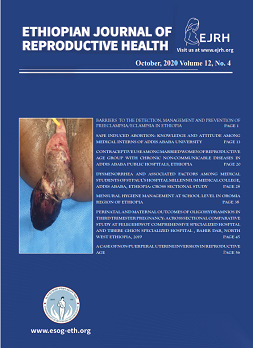BARRIERS TO THE DETECTION, MANAGEMENT and PREVENTION OF PREECLAMPSIA/ECLAMPSIA IN ETHIOPIA: FORMATIVE REVIEW
DOI:
https://doi.org/10.69614/ejrh.v12i4.406Abstract
Abstract
Background: Preeclampsia is the third leading cause of maternal mortality in Ethiopia accounting for 11% of maternal deaths. Barriers to the diagnosis, management and prevention of Preeclampsia are not well studied in Ethiopia.
Objectives: To explore barriers to the detection, management, and prevention of preeclampsia/ Eclampsia in Ethiopia
Methods: Desk review of Scientific papers, Health surveys, and national documents were done after employing a search strategy and browsing through databases (PubMed, Google Scholar,). Eight in-depth interviews with relevant stakeholders were also done for supplementation. Framework for analysis of barriers was devised and thematic synthesis of findings done
Results: Eight primary studies; three demographic surveys (DHS) and 11 national documents (2 policy papers; 2 legislations; 4 guidelines; 1 protocol and 2 training materials were included for data synthesis from the desk review. There is no national policy exclusively on preeclampsia. All drugs used in the management of preeclampsia/eclampsia are included in the essential medicine list but are not registered. In the standard guidelines, which health professionals could administer Magnesium is not specified. Moreover, elements of referral are not detailed and pre-referral care is substandard. None of the documents have recommended Aspirin for the prevention of preeclampsia. There is no national protocol on Preeclampsia care. But the national emergency Obstetric care training material has included updated information on Magnesium, anti-hypertensives, and Aspirin. Administration of loading dose magnesium at lower health facilities is not approved in any of the documents. There was a significant gap in drug procurement, distribution, and availability.
At health facility level inadequate training; perceived inability to provide Magnesium; lack of local guidelines; substandard quality care and Poor knowledge on preeclampsia by health providers were barriers whereas delayed care-seeking; alternative cultural remedies and poor awareness on preeclampsia were barriers at the community level.
Conclusion: There are substantial barriers to the detection, management, and prevention of Preeclampsia at all levels of health care provision which should be addressed with a concerted effort from all responsible stakeholders.
Key Words: Preeclampsia, Eclampsia, Barriers, Diagnosis, Management, Prevention



